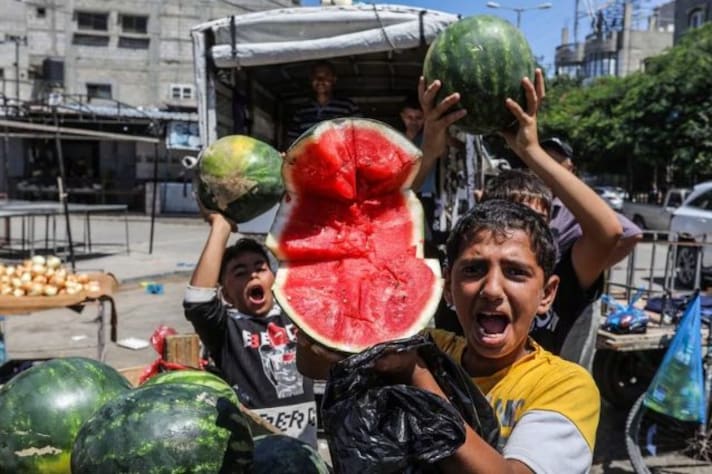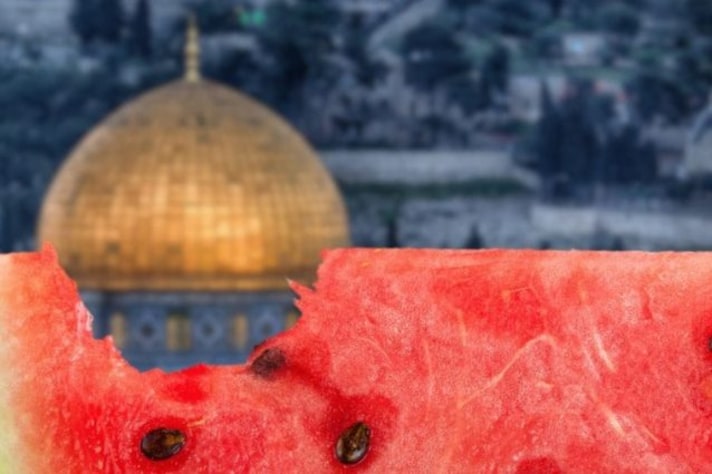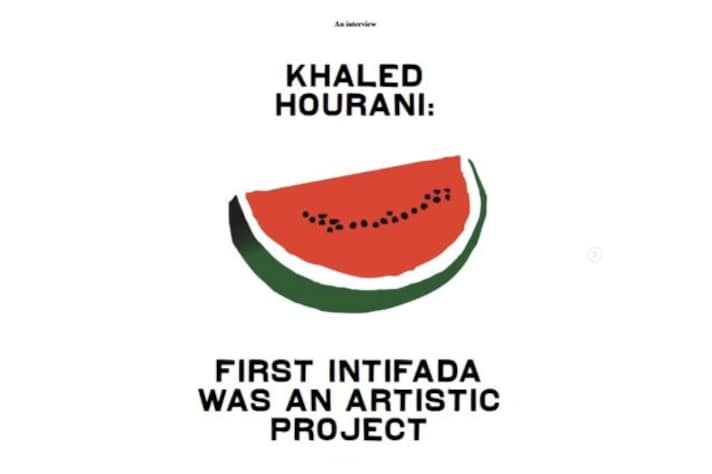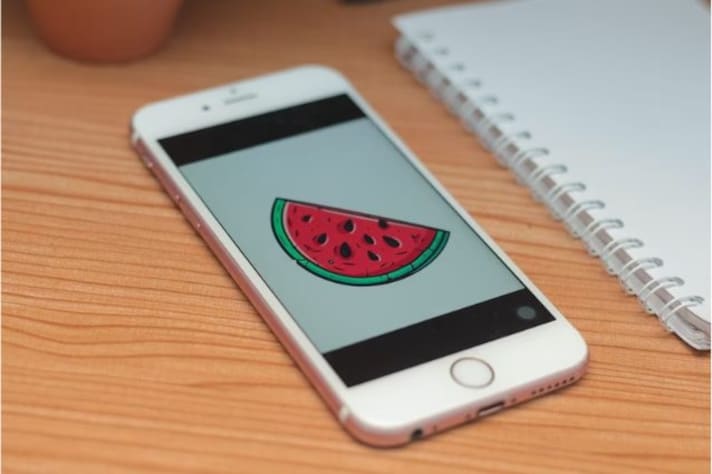How Did The Watermelon Become a Symbol of Palestine? The History Behind This Connection
The most obvious connection is in the colors: the Palestinian flag and the fruit have the same pattern. The connections are deeper and older than we imagine.

There is no official connection between watermelon and Palestine as a national or cultural symbol, yet for years this delicious fruit has been associated with the Middle Eastern nation. But where does this strange union come from? The most immediate connection is chromatic. The colors of the Palestinian flag are the same as those of watermelon: red, black, white and green. A particular coincidence that has led over the years to circumvent some censorship regulations to pay homage to Palestine: artists from all over the world have drawn or photographed watermelons to show their support for Palestine for the occupation of Gaza and the West Bank. These days this connection is more relevant than ever, let's try to find out more.
What Does a Watermelon Have to Do With Palestine?
This symbol that seems to have sprung up by chance in recent days actually has very ancient origins. According to popular belief, it was even born in 1967: some Palestinian activists transported slices of watermelon to Gaza and the West Bank to circumvent the ban on displaying the Palestinian flag in the region. At the time, it was considered a criminal offense, punishable by arrest.

We are not sure if this protest is real because the evidence to support this hypothesis is a bit fragmentary so we date this protest, officially, to 1980. As artist Sliman Mansour tells The National, the Israeli government over the years has not limited itself to repressing the Palestinian flag, it has implemented actual boycotts. In 1980 Mansour presented an art show with other important colleagues such as Nabil Anani and Issam Badrl at the 79 Gallery in Ramallah, home of the International Academy of Art Palestine (IAAP): the police rushed in and closed the entire structure, a few hours after it opened. The reason? "They told us that it was forbidden to paint the Palestinian flag, even the colors were forbidden." Badrl tries to hypothesize, dealing with the officials, the realization of a painting with a red, green, black and white flower but the police officer threatens him with confiscation, adding "even if you draw a watermelon we confiscate it". The idea actually pleases the artists and it would have been paradoxical even for the Israeli government to prohibit the representation of an existing fruit, so until 1993 the watermelon becomes the protagonist of the paintings and illustrations of activists from all over the world.
In '93 things changed, they improved a little, because thanks to the Oslo Accords there was mutual recognition by Israel and the Palestine Liberation Organization with the consequent lifting of the ban on the Palestinian flag. It was a period of great trust because for the first time, after decades of civil wars, there were formal agreements to try to resolve the Israeli-Palestinian conflict. The flag was accepted as representing the Palestinian Authority, which would administer Gaza and the West Bank: so the watermelon was gone. The New York Times of the time, with the prestigious signature of a journalist who made history in America like John Kifner, recounted this strange passing of the baton: "In the Gaza Strip, where once some young people were arrested for carrying sliced watermelons – thus displaying the Palestinian colors of red, black and green – the soldiers stood by, indifferent, as the processions marched waving the once-banned flag".

We know all this because the artist Khaled Hourani in 2007, immediately after the Second Intifada, wrote a "Subjective Atlas of Palestine" from which he extracted " The Story of the Watermelon ". Thanks to him this symbol has come back into fashion because in 2013 he made a print and called it " The Colors of the Palestinian Flag " even though it simply represents a drawn slice of watermelon. His painted slice of watermelon goes around half the world: Scotland, France, Algeria, Jordan, Lebanon, China and Egypt among other nations.
This symbol lives in cycles, and while it went viral 10 years ago, it has since faded away again thanks to times of peace . The use of the watermelon as a symbol has returned strongly in 2021, following an Israeli court ruling that Palestinian families based in the Jerusalem neighborhood of Sheikh Jarrah would be evicted from their homes to make way for settlers.
Since the watermelon has now become accepted, various artists have created new symbols: Sami Boukhari uses prickly pears because before 1948 they served as a natural border that separated the different land properties in agricultural areas. '48 is not a random year: May 14, 1948 is the day of the proclamation of the State of Israel, after the UN decision to establish a Jewish state and an Arab state to try to resolve the internal conflicts of Palestine.

"During the Nakba of 1948, cities were severely damaged and 532 Palestinian villages were destroyed to the ground, to prevent the return of their inhabitants. To this day, they are still forbidden from returning to their homeland. They were defined by Israel as “present absentees” so that their property could be confiscated by the new state. Even the Palestinians who remained after the war were forcibly displaced from their homes, their land and property were plundered, the original population expelled, but the borders drawn by prickly pears have survived to this day," he writes on Instagram. In 2021, watermelon was replaced by tomatoes due to an absurd Israeli law: the government forces Palestinian farmers working in the Gaza Strip to remove the stalk, the green part of the plant, before sending the fruit to the markets via the Karm Abu Salem crossing. They do it partly because the colors recall the Palestinian flag, and partly to damage the economy: tomatoes without "stems" have a shorter life.
Watermelon's Role Today, During the New Conflict
Today everything has changed and the watermelon is back in vogue but in a different guise: in recent days on platforms like TikTok and X, watermelons are becoming popular in the form of hashtags or emojis, in relation to the war in Palestine. Just take a look at social media and you will see that every post that talks about the war has sad emojis, flags and watermelons.

Today's problem is not about oppressive rules of the Israeli government but perhaps something even more disturbing: Meta, the parent company of Instagram, Facebook and Whatsapp among others, penalizes posts that contain words like Hamas, Palestine, Gaza, #freepalestine by showing them to as few people as possible. A censorship demonstrated by many parties that forces social pages or simple newspapers to find alternative methods to avoid the ban: it is called " algospeak ", a language in which instead of words, images, symbols and/or numbers are used to indicate topics or to confuse the algorithm on the words used. This applies to everyone, not just to pages aligned with one side or the other: even just telling the conflict in the most aseptic way possible leads to penalization.
On social media, in addition to the hashtag, there is a very popular account, @watermelonmovement opened in 2021, which carries on the battle for "liberation, justice and equality" for Palestine. The initiative of the tiktoker Jourdan Louise is very praiseworthy : she created a filter (which has been used over 4 million times), the profits of which will be donated to charity to organizations that help the citizens of Gaza under siege.
;Resize,width=767;)

;Resize,width=712;)

